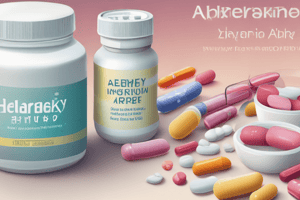Podcast
Questions and Answers
What is the primary action of cromolyn in the treatment of allergies?
What is the primary action of cromolyn in the treatment of allergies?
- Suppresses the cough reflex in the CNS and provides analgesia
- Increases respiratory tract fluid, reducing the viscosity of mucus
- Blocks the effects of histamine at H1 receptors
- Inhibits mast cell degranulation, preventing the release of histamine (correct)
What is a common adverse effect of diphenhydramine?
What is a common adverse effect of diphenhydramine?
- Nasal irritation
- Paradoxical excitement, especially in children
- Tachycardia
- All of the above (correct)
What is the therapeutic use of fluticasone?
What is the therapeutic use of fluticasone?
- Pulmonary disorders with thick tenacious mucus
- Nasal congestion
- Cough suppression
- Allergic rhinitis (correct)
What is the primary action of oxymetazoline?
What is the primary action of oxymetazoline?
What is the contraindication for the use of acetylcysteine?
What is the contraindication for the use of acetylcysteine?
What is the mechanism of action of albuterol?
What is the mechanism of action of albuterol?
What is the therapeutic use of ipratropium?
What is the therapeutic use of ipratropium?
What is the mechanism of action of phenylephrine?
What is the mechanism of action of phenylephrine?
What is the therapeutic use of methylxanthines?
What is the therapeutic use of methylxanthines?
What is a common adverse effect of oxymetazoline?
What is a common adverse effect of oxymetazoline?
What is the pharmacological action of Montelukast?
What is the pharmacological action of Montelukast?
What is a rare adverse effect of Montelukast?
What is a rare adverse effect of Montelukast?
What is the therapeutic use of Cromolyn sodium?
What is the therapeutic use of Cromolyn sodium?
How often should Cromolyn sodium be inhaled?
How often should Cromolyn sodium be inhaled?
What is the mechanism of action of Reslizumab?
What is the mechanism of action of Reslizumab?
What is a black box warning for Isoniazid?
What is a black box warning for Isoniazid?
What is a side effect of Rifampin?
What is a side effect of Rifampin?
What is the therapeutic use of Isoniazid?
What is the therapeutic use of Isoniazid?
Study Notes
Mast Cell Receptor Stabilizers
- Cromolyn inhibits mast cell degranulation, preventing the release of histamine.
- Nursing interventions: instruct on proper inhaler or nasal spray technique and use prior to exposure.
H1 Receptor Antagonists
- Diphenhydramine (Benadryl) blocks the effects of histamine at H1 receptors, resulting in antihistamine effects.
- Adverse effects: photosensitivity, paradoxical excitement (especially in children), anticholinergic effects, dry mouth, tachycardia, and hypertension.
- Contraindications: hypersensitivity, narrow-angle glaucoma, BPH, and GI obstruction.
Intranasal Corticosteroids
- Fluticasone is used for allergic rhinitis and inhibits inflammatory pathways.
- Side effects: nasal irritation and epistaxis (nose bleeds).
- Adverse effects: systemic effects with prolonged use, especially with oral steroids.
- Contraindications: hypersensitivity and infection.
Decongestants
- Oxymetazoline stimulates alpha-adrenergic receptors, causing sympathomimetic vasoconstriction of nasal blood vessels.
- Side effects: rebound congestion with prolonged use, nasal irritation, minor stinging, and dryness.
- Nursing interventions: limit use to 3-4 consecutive days to prevent rebound congestion.
- Contraindications: hypertension, diabetes, thyroid disorder, and heart disease.
Antitussives
-
Dextromethorphan suppresses the cough reflex in the CNS and provides analgesia.
-
Side effects: dizziness, drowsiness, and nausea.
-
Adverse effects: rare, but can cause slurred speech, ataxia, hyperexcitability, stupor, respiratory depression, seizures, coma, and toxic psychosis.
-
Contraindications: concurrent use of MAOIs.
-
Patient teaching: avoid alcohol use and be cautious with other CNS depressants.
-
Codeine cough syrup suppresses the cough reflex via the CNS and provides analgesia.
-
Side effects: sedation, constipation, and respiratory depression.
-
Nursing interventions: monitor for respiratory depression and assess for pain relief.
-
Contraindications: patients with asthma due to bronchoconstriction.
Expectorants
- Guaifenesin increases respiratory tract fluid, reducing mucus viscosity.
- Therapeutic use: productive cough and mucus clearance.
- Contraindications: hypersensitivity and children under six.
Mucolytics
- Acetylcysteine breaks disulfide bonds in mucus, reducing its viscosity.
- Therapeutic use: pulmonary disorders with thick, tenacious mucus, such as cystic fibrosis and chronic bronchitis.
- Note: has a rotten egg smell.
Beta-Adrenergic Agonists
- Albuterol is a selective beta-2 adrenergic agonist and bronchial dilator.
- Therapeutic use: acute bronchospasm.
- Adverse effects: palpitations, headaches, throat irritation, tremors, restlessness, nervousness, and tachycardia.
- Contraindications: hypersensitivity, cardiovascular effects, and concurrent use of beta blockers.
- Interactions: concurrent use of MAOIs within 14 days of beginning therapy.
Anticholinergics
- Ipratropium is an anticholinergic bronchial dilator.
- Therapeutic use: COPD, asthma, and exacerbations.
- Adverse effects: upper respiratory tract irritation, cough, dry nasal mucus, hoarseness, and contraindications: hypersensitivity to soybeans and peanuts.
Alpha-Adrenergic Agonists
- Phenylephrine stimulates alpha-1 receptors, constricting nasal blood vessels.
- Therapeutic use: nasal congestion.
- Adverse effects: increase in blood pressure, bradycardia, burning of the mucosa, and rebound congestion with prolonged use.
- Contraindications: acute pancreatitis, heart disease, hepatitis, or narrowing angle glaucoma.
Leukotriene Modifiers
- Montelukast is a leukotriene receptor antagonist.
- Side effects: headache and nausea, diarrhea.
- Adverse effects: neuropsychiatric events (rare), such as suicide ideations, hallucinations, aggressiveness, or depression.
- Nursing interventions: monitor ALT levels.
- Contraindications: hepatic impairment.
Monoclonal Antibodies
- Reslizumab (Cinqair) binds to interleukin-5 (IL-5).
- Omalizumab (Xolair) attaches to receptors on immunoglobulin E (IgE).
Anti-Tubercular Drugs
-
Isoniazid inhibits microorganism cell wall synthesis.
-
Therapeutic use: tuberculosis.
-
Adverse effects: neurotoxicity, paresthesia of the feet and hands, compulsions, optical neuritis, dizziness, memory loss, and various psychoses.
-
Black box warning: hepatotoxicity.
-
Rifampin inhibits DNA-dependent RNA polymerase in mycobacteria.
-
Mechanism of action: inhibits bacterial RNA synthesis.
-
Side effects: orange discoloration of bodily fluids, gastrointestinal upset.
-
Adverse effects: hepatotoxicity (rare but serious).
Studying That Suits You
Use AI to generate personalized quizzes and flashcards to suit your learning preferences.
Description
This quiz covers the pharmacological actions and nursing interventions of Cromolyn, a mast cell receptor stabilizer, and Diphenhydramine, an H1 Receptor Agonist. Learn about their effects on histamine release and blocking.




